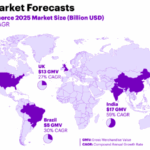Ecommerce, often described as cross-border commerce, borderless business, and international online retail, has transcended mere definitions. It’s no longer a luxury or just one of many business strategies; it has become a necessity. In the digital age, becoming an online business is imperative for reaching global audiences and staying competitive.
Yet, with the vast potential of ecommerce comes a myriad of questions for businesses seeking to thrive in this landscape. Where should you invest your resources? Which countries offer the best product-market fit for your business? How can you attract customers from around the world? Is it all about translation, currency options, payment methods, or is there more to the equation?
In this comprehensive guide, we will provide you with invaluable insights into the world of global ecommerce and offer practical tips on how you can successfully expand into international markets.
Understanding Global Ecommerce
Global ecommerce, at its core, involves the sale of products or services across geopolitical borders from a company’s country of origin. This often refers to the country where the company was founded or incorporated. Products or services are marketed and sold into markets outside of their native region through online sales and marketing channels.
The advantages of venturing into international ecommerce are substantial:
- Easier Expansion: Breaking into foreign markets becomes more accessible through ecommerce.
- Product-Market Fit: It becomes easier to identify and adapt to the preferences and needs of diverse markets.
- Shorter Sales Cycles: Business-to-business (B2B) sales cycles tend to be shorter in the digital realm.
- Swift International Presence: Building a global brand presence can be achieved more rapidly.
- Lower Barriers: Ecommerce often has lower barriers to entry compared to traditional business models.
Top 15 Global Ecommerce Statistics and Trends for 2023
If you’re operating an online store, staying informed about the latest ecommerce trends and statistics is crucial for maximizing your revenue and making informed business decisions. Here are the top 15 ecommerce statistics from around the world to keep you well-prepared for the year ahead:
- China’s Dominance: China continues to lead in global ecommerce sales, accounting for over 50% of all retail sales worldwide, with online sales exceeding $3 trillion in 2022.
- UK’s Significance: After China and the US, the United Kingdom claims the third-largest share of ecommerce sales at 4.8%, with projected sales of over $143.8 billion in 2023.
- Latin America’s Growth: Latin American countries, including Peru, Brazil, Argentina, Chile, Colombia, and Mexico, witnessed a 22.4% increase in ecommerce sales in 2022, reaching $104 billion.
- Singapore’s Surge: Singapore ranks among the top five fastest-growing ecommerce markets globally, with a remarkable 25.5% growth in sales during 2022.
- US Projections: The US ecommerce market is expected to surpass $940.9 billion in 2023, representing approximately one-third of China’s total ecommerce sales.
- US Online Shoppers: An estimated 218.8 million US consumers are projected to shop online in 2023.
- Preference for Free Delivery: Over 50% of consumers prioritize online shopping platforms that offer free delivery, followed by discounts and coupons at 38.7%.
- Cart Abandonment Rates: The average shopping cart abandonment rate is reported at 70.19%, highlighting the importance of optimizing the online shopping experience.
- Mobile Shopping: 28% of US shoppers use mobile phones while in physical stores to search for discounts, compare products, and read reviews.
- Influence of Recommendations: Approximately 30% of consumers credit influencer recommendations for guiding their online purchases, slightly surpassing recommendations from friends or family at 27%.
- Conversion Rates: As of May 2023, the average conversion rate across ecommerce sites stood at 2.02%, showing a 0.2 percentage point increase from the previous month.
- B2C Marketplace Sales: Business-to-consumer (B2C) online marketplace sales in the US are projected to reach $2.1 trillion by 2024, with platforms like Amazon and eBay leading the way.
- Ecommerce vs. Retail Growth: In 2022, the gap between ecommerce growth and traditional retail growth was minimal, underscoring the continued rise of digital commerce.
- Millennial Shoppers: In 2022, there were 41.8 million online shoppers between the ages of 25 and 34, with millennials forming the largest group among digital buyers.
2023 Ecommerce Trends to Watch
Looking ahead to 2023, several key trends are shaping the ecommerce landscape:
- Global Inflation Pressures: Ecommerce businesses must navigate the challenges posed by rising global inflation rates.
- Mobile Shopping: More consumers are expected to shop on their smartphones, emphasizing the need for mobile-friendly ecommerce platforms.
- Stabilizing Supply Chain: Ecommerce companies are gradually adapting to a stabilizing supply chain, which had faced disruptions in recent years.
- Localized Content: Creating content in customers’ local languages is becoming increasingly important for engaging and converting international shoppers.
In conclusion, ecommerce is not just a business strategy; it’s a fundamental component of modern commerce. The global ecommerce landscape is evolving rapidly, offering vast opportunities for businesses willing to adapt and expand their reach. By staying informed about ecommerce trends and leveraging the insights provided here, your business can thrive in this dynamic and competitive digital marketplace.










